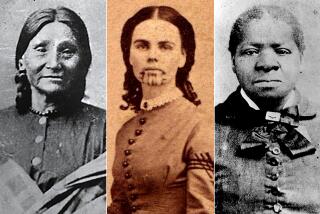On the Cutting Edge of Settling the West
- Share via
Question: Did barbed wire, the kind that helped settle the Wild West, start out that way or was it of a different design? I have a considerable collection of the stuff that I’ve tried to categorize and mount for display purposes.--P.V.
Answer: Actually, the history of barbed wire begins with smooth strands that were used by Western settlers in the 1850s. The non-barbed, single-strand variety was patented by a Texan, W. H. Meriwether, and apparently there are some people who have identified genuine Meriwether wire in their collections.
The primary problem with Meriwether’s invention--and variations that followed--was that it was vulnerable both to the weather and hard-charging cattle. Thus, the evolution of barbed wire, which was stronger and more lasting--and highly collectible.
Barbed wire rolled out on a mass-production basis appears to have been manufactured by Michael Kelly of New York during the Civil War. Kelly’s wire also is highly prized by collectors.
Double Strand
About a decade later, Joseph Glidden of Illinois modified the Kelly design, producing a double strand of barbed wire that was supposed to keep cattle penned.
After that, several hundred different patents were issued for barbed-wire designs through the turn of the century. Additionally, collectors say many designs weren’t patented; therefore, there may be more than a thousand designs to collect.
Apparently, this is another collectible area plagued with counterfeits, so individuals new to the field should be wary and consult with veteran collectors.
Q: I have a number of circus posters, mostly reproductions. However, they’re in super shape. Does their value diminish just because they’re reproductions?--H.M.
A: Although some collectors believe that when you practically corner the market in circus-poster reproductions, you have single-handedly made them “valuable,” the rule of thumb is that reproductions are never as valuable as the originals.
Experienced collectors can spot circus-poster reproductions right away.
First, reproductions are usually cut smaller and to a different dimension than the originals, which generally were 40 to 42 inches long by 27 to 30 inches wide.
Secondly, reproductions may have a glossier finish, whereas originals did not use slick paper stock. On this note, collectors say they generally look for posters produced by early lithographic printing processes, and that modern printing techniques quickly give away a poster’s age.
Finally, the printer’s name should be clear, whereas a reproduction might fuzz the name.
Most sought-after circus posters appear to have been printed in a 100-year span beginning in the 1870s. Thousands of such posters may have been printed to advertise the coming of just one circus to a particular town.
The advertising work was usually done by members of advance crews, who worked on trains that visited circus sites weeks before the actual circus arrived.
For these posters, prices certainly have climbed in recent years. A catalogue check of dealer prices shows that, for example, Ringling Bros. Circus posters produced in the 1890s have brought $400 and more for a single poster.
Mailbag
Thank you, A.T. of La Canada, for sending us that colorful swatch of Lone Ranger wallpaper; we forwarded it to L.F., who recently inquired about Lone Ranger collectibles. The graphics of the Lone Ranger and Tonto were uncovered, A.T. said, from an old wallpaper sample book that had been converted into a family scrapbook.
Until reading about L.F.’s hobby, she said, she had saved the Lone Ranger sample “as a joke . . . telling my grown sons I was thinking of papering their wall with it!”
Bookshelf
The 12th edition of the coffeetable book “Bradford Book of Collector’s Plates” is being sold at gift and collectibles shops ($24.50, 464 pages, indexed). The book contains color photos of almost 1,500 plates listed on the Bradford Exchange, with additional information on another 7,200 plates not listed but traded in the so-called over-the-counter plate market.
“There are now 7 million plate collectors in the United States,” said Barbara B. White, executive editor of the book, in a statement issued by the Niles, Ill., company. “And although domestically produced editions still account for the majority of plate introductions, dozens of new issues from foreign producers have successfully entered the U.S. market recently.”
The book can also be ordered by telephone ($26.25, including postage and handling): (800) 323-5577.
More to Read
Sign up for The Wild
We’ll help you find the best places to hike, bike and run, as well as the perfect silent spots for meditation and yoga.
You may occasionally receive promotional content from the Los Angeles Times.






